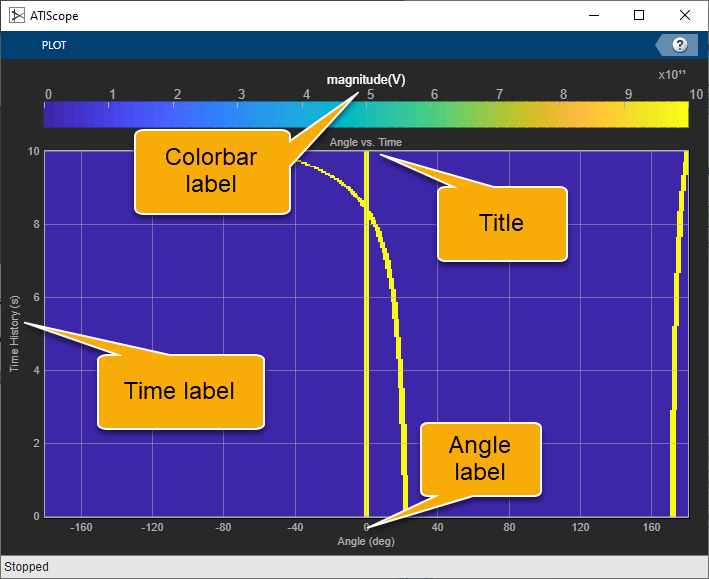Angle-Time Intensity Scope
Libraries:
Phased Array System Toolbox /
Sinks
Description
The Angle-Time Intensity Scope block creates a scrolling display of angle response intensities as a function of time. The input consists of angle responses for a pulse or FMCW signal. Each frame of data creates a new line on the scope. The scope serves as a display of the angle response.

Examples
Direction of Arrival with Beamscan and MVDR
Use beamscan and minimum variance distortionless response (MVDR) techniques for direction of arrival (DOA) estimation in Simulink®. It is based on the MATLAB® example Direction of Arrival Estimation with Beamscan, MVDR, and MUSIC.
Ports
Input
Input data, specified as a real-valued length-M vector of angle responses. Each vector corresponds to a line of data. The block can accept single precision data type input, but converts the data to double precision for display.
Data Types: double | single
Parameters
Angle offset, specified as a scalar. This property defines the angle value of the first column of the display. Units are in degrees.
Programmatic Use
Block
Parameter:AngleOffset |
| Type:double |
Values:scalar | |
| Default:0.0 |
Data Types: double
Angle separation between samples, specified as a positive scalar. This property defines the angle difference between columns of the scope. Units are in degrees.
Programmatic Use
Block
Parameter:AngleResolution |
| Type:double |
Values:positive scalar | |
| Default:0.0 |
Data Types: double
Time span of the intensity display, specified as a positive scalar. When the
Time span (s) is set to Auto the simulation
stops at the default stop time of the simulation. Units are in
seconds.
Programmatic Use
Block
Parameter:TimeSpan |
| Type:double |
| Values:scalar |
Default:0.1 |
Data Types: double
Time interval between rows, specified as a positive scalar. This property defines
the time duration between rows of the scope. When the Time resolution (s)
parameter is set to Auto the block uses the
Compiled Sample Time value during simulation. At all other
times, the block uses the value specified by this parameter. Units are in
seconds.
Programmatic Use
Block
Parameter:TimeResolution |
| Type:double |
| Values:positive scalar |
Default:0.001 |
Data Types: double
Show Cartesian grid overlay. To show the grid, select the check box.
Programmatic Use
Block
Parameter:ShowGrid |
| Type:logical |
| Values:1 | 0 |
Default:1 |
Show value labels on tick marks. To display the labels, select the check box.
Programmatic Use
Block
Parameter:ShowTicks |
| Type:logical |
| Values:1 | 0 |
Default:1 |
Labels
Angle-axis label, specified as a character vector or a string.
Example: 'Angle (rad)'
Tunable: Yes
Programmatic Use
Block
Parameter:AngleLabel |
| Type:string |
| Values:string |
Default:'Angle
(degree)' |
Data Types: char | string
Time-axis label, specified as a string.
Tunable: Yes
Programmatic Use
Block
Parameter:TimeLabel |
| Type:string |
| Values:string |
Default:'Time History
(s)' |
Data Types: string
Window title, specified as a string.
Tunable: Yes
Programmatic Use
Block
Parameter:Title |
| Type:string |
| Values:string |
Default:'Doppler vs.
Time' |
Data Types: char
Color bar label, specified as a string.
Tunable: Yes
Programmatic Use
Block
Parameter:ColorBarLabel |
| Type:string |
| Values:string |
Default:'dB' |
Data Types: string
Block Characteristics
Data Types |
|
Direct Feedthrough |
|
Multidimensional Signals |
|
Variable-Size Signals |
|
Zero-Crossing Detection |
|
More About
This section shows how to run the scope, configure the settings to show labels for the
various features and use the cursor to examine data. The scope is based on the phased.ATIScope
System object™. Using the scope to display response corresponds to setting the
IQDataInput property of the phased.ATIScope
System object to false.
After selecting and opening the block, the scope displays a single tab PLOT. Click the tab to show all the controls available for the block. The Settings menu displays all the settable parameters for the scope. The Step Back, Run, Step Forward, and Stop buttons control the simulation. The Data Cursors button lets you examine data values on the display.

Clicking the Settings button on the PLOT tab opens the parameter window with the DATA AND AXES and LABELS parameters.

DATA AND AXES
Angle offset (Hz) – Use this field to set the frequency offset of the x-axis.
Angle resolution (Hz) – Use this field to set the granularity of the x-axis.
Time span (s) – Use this field to set the duration of the y-axis.
Time resolution (s) – Use this field to set the granularity of the y-axis.
LABELS
Angle label – Use this field to set the y-axis label.
Time label – Use this field to set the y-axis label.
Title – Use this field to set the display title.
Colorbar label – Set this field to set the color bar label.

Click the Data Cursors button to display the screen cursors. Each cursor consists of intersecting horizontal and vertical cursors that define a point on the display. Positioning two cursors on the display shows the difference between the intensities at the two cursor points.

Extended Capabilities
This block can be used for simulation visibility in systems that generate code but is not included in the generated code.
Version History
Introduced in R2022b
MATLAB Command
You clicked a link that corresponds to this MATLAB command:
Run the command by entering it in the MATLAB Command Window. Web browsers do not support MATLAB commands.
웹사이트 선택
번역된 콘텐츠를 보고 지역별 이벤트와 혜택을 살펴보려면 웹사이트를 선택하십시오. 현재 계신 지역에 따라 다음 웹사이트를 권장합니다:
또한 다음 목록에서 웹사이트를 선택하실 수도 있습니다.
사이트 성능 최적화 방법
최고의 사이트 성능을 위해 중국 사이트(중국어 또는 영어)를 선택하십시오. 현재 계신 지역에서는 다른 국가의 MathWorks 사이트 방문이 최적화되지 않았습니다.
미주
- América Latina (Español)
- Canada (English)
- United States (English)
유럽
- Belgium (English)
- Denmark (English)
- Deutschland (Deutsch)
- España (Español)
- Finland (English)
- France (Français)
- Ireland (English)
- Italia (Italiano)
- Luxembourg (English)
- Netherlands (English)
- Norway (English)
- Österreich (Deutsch)
- Portugal (English)
- Sweden (English)
- Switzerland
- United Kingdom (English)
